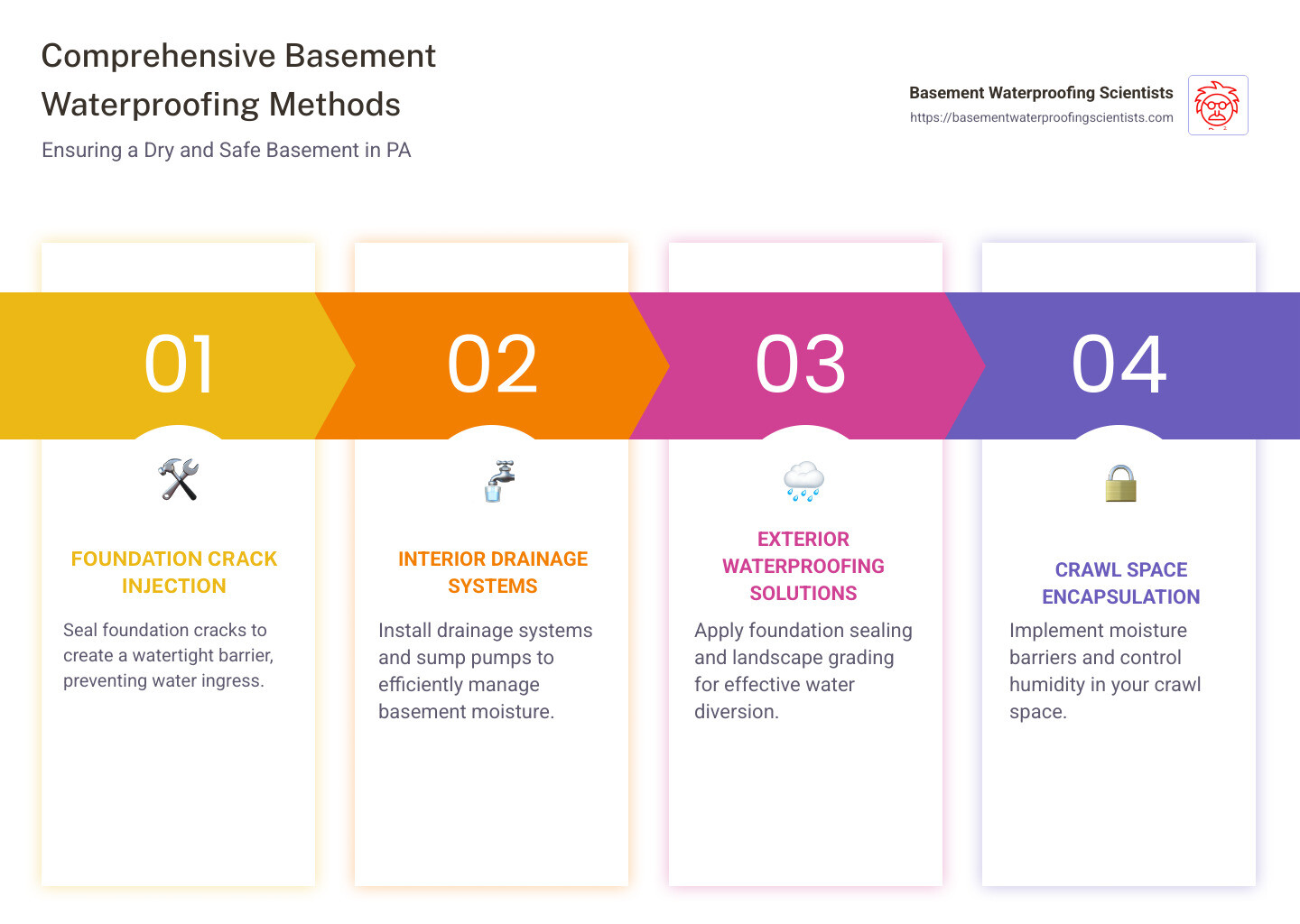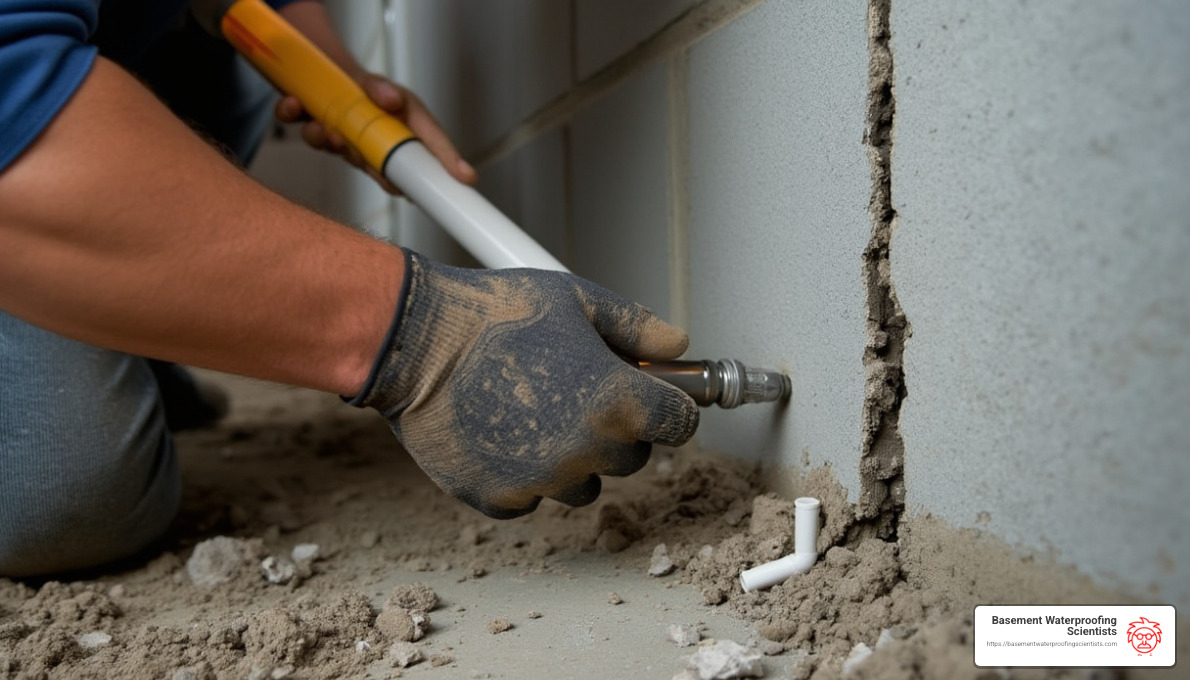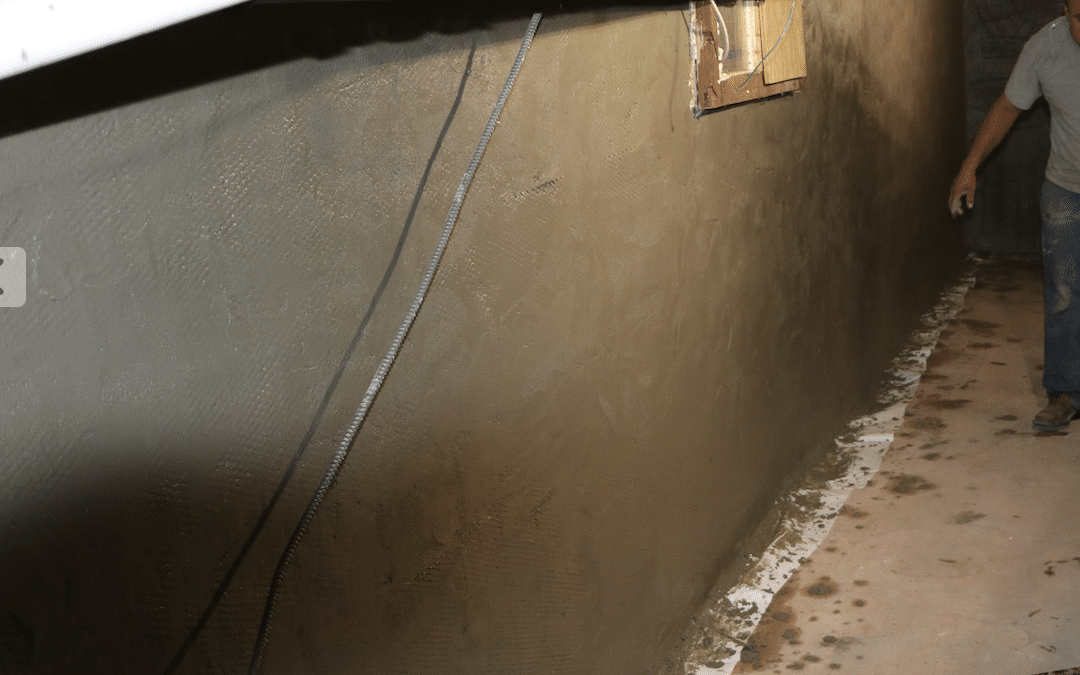Basement Waterproofing PA is crucial for homeowners dealing with pesky water issues that turn their lower levels into damp, unusable spaces. As a basement waterproofing specialist, I emphasize expertise in addressing these water-related issues to ensure a dry, safe, and mold-free environment. Using cutting-edge technology in our basement waterproofing methods allows us to accurately diagnose and create tailored solutions for each home. Here are the top methods to protect your home:
-
Foundation Crack Injection – Seal foundation cracks to create a watertight barrier.
-
Interior Drainage Systems – Install drainage systems and sump pumps to control moisture.
-
Exterior Waterproofing Solutions – Use foundation sealing and landscape grading for water diversion.
-
Crawl Space Encapsulation – Implement moisture barriers and control humidity.
-
Dehumidification and Ventilation – Use dehumidifiers for effective mold prevention.
In Pennsylvania’s varying climate conditions, these methods provide reliable solutions custom to meet individual needs and protect your home’s structural integrity.
I’m Darin Garvey, with a wealth of experience in Basement Waterproofing PA. As an expert, I specialize in crafting state-of-the-art, custom solutions for a dry and secure home environment. Transitioning next, we explore each waterproofing method to help you find the best fit for your needs.

Foundation Crack Injection
Foundation crack injection is a proven method for sealing cracks in your basement walls and addressing foundation issues, creating a watertight barrier. This technique is essential for preventing water from seeping into your home, which can lead to mold growth and structural damage. Foundation repair is a critical service to maintain the structural integrity of homes facing various foundation issues.
How It Works
-
Identify the Crack: First, experts assess the crack to determine its type and severity. This step ensures the right repair method is chosen.
-
Clean the Crack: The crack is cleaned thoroughly using tools like a hammer, chisel, and wire brush. This removes loose debris and dust, ensuring a strong bond for the repair material.
-
Install Injection Ports: Small ports are placed along the crack at regular intervals—usually 8-12 inches apart. These ports allow for precise injection of the sealant.
-
Seal the Crack: A thin layer of epoxy or polyurethane adhesive is applied over the crack, covering the injection ports to prevent leaks.
-
Inject the Sealant: Once the adhesive cures, epoxy or polyurethane is injected through the ports. This fills the crack from top to bottom, creating a solid barrier against water intrusion.
-
Finish the Surface: After the sealant cures, the ports are removed, and the surface is smoothed out to blend with the surrounding concrete.

Why It Matters
Foundation cracks can lead to serious issues if not addressed promptly. Water infiltration can cause:
-
Mold Growth: Moist environments encourage mold, which can affect your health and your home’s air quality.
-
Structural Damage: Persistent water intrusion can weaken your foundation, leading to costly repairs.
By opting for foundation crack injection, you ensure a long-lasting solution that protects your home from these risks. Plus, it’s a cost-effective way to maintain your property’s value and safety.
In Pennsylvania’s climate, where rainfall and humidity can vary, having a watertight barrier is crucial. This method not only addresses current cracks but also fortifies your home against future water challenges.
Next, we’ll dive into Interior Drainage Systems, exploring how they work to keep your basement dry and mold-free.
Interior Drainage Systems
Keeping your basement dry is crucial, and interior drainage systems play a vital role in achieving this. These systems are designed to manage water that seeps into your basement, ensuring effective moisture control. Let’s explore how these systems work and why they’re essential for Basement Waterproofing PA. Homeowners can also receive a free estimate for interior drainage system installation.
How Interior Drainage Systems Work
-
Perimeter Drainage Channels: These channels are installed along the basement’s interior perimeter. They capture water that seeps through walls and floors, directing it away from your living space.
-
Sub-Floor Pressure Relief System: Often referred to as a French drain, this system involves a trench filled with gravel and a perforated pipe. It effectively manages hydrostatic pressure, which can force water into your basement.
-
Sump Pumps: As water is collected by the drainage channels, it’s directed to a sump basin. Here, a sump pump takes over, pumping water out of the basement and away from your home. Sump pumps are critical in preventing flooding, especially during heavy rains.
-
Battery Backup Systems: To ensure continuous operation during power outages, battery backup systems are available. These systems keep your sump pump running, providing peace of mind even during emergencies.
Benefits of Interior Drainage Systems
-
Effective Moisture Control: By redirecting water, these systems prevent moisture buildup, reducing the risk of mold and mildew.
-
Preservation of Structural Integrity: Keeping water away from your foundation helps maintain its strength, preventing costly structural damage.
-
Quick Installation: In many cases, interior drainage systems can be installed within 1-3 days, offering a fast solution to keep your basement dry.
-
Cost-Effective: While the average cost for basement waterproofing ranges between $4,000 and $8,000, interior drainage systems provide a reliable and affordable option compared to more invasive solutions.
Real-Life Impact
A homeowner in Philadelphia faced constant basement flooding during heavy rains. After installing an interior drainage system with a sump pump, they reported a completely dry basement, even during the heaviest downpours. This solution not only protected their home but also improved their quality of life by eliminating mold risks.
For more information on how these systems can transform your basement, visit Basement Waterproofing Scientists.
Next, we’ll explore Exterior Waterproofing Solutions, which focus on keeping water away from your foundation.
Exterior Waterproofing Solutions
While interior systems manage water that enters your basement, exteriorwaterproofingsolutions focus on keeping water away from your foundation in the first place. Our foundation repair specializes in both basement waterproofing and structural repairs, ensuring comprehensive protection for your home. Let’s explore some key methods: foundation sealing, landscape grading, and water diversion.
Foundation Sealing
Foundation sealing is a critical step in exterior waterproofing. Using premium materials for effective waterproofing enhances the durability and reliability of the seal, providing customized protection against moisture intrusion.
Foundation Sealing
Foundation sealing involves applying a protective barrier to the outside of your foundation walls. This sealant is typically a waterproof coating that prevents water from seeping through the concrete.
-
Why It’s Important: Sealing your foundation is essential for creating a watertight barrier. It helps stop water at its source, protecting your basement from potential leaks and moisture intrusion.
-
Application Process: A professional will clean the foundation surface, apply the sealant, and ensure it’s fully cured before backfilling the soil. This process can significantly extend the lifespan of your foundation.
Landscape Grading
Landscape grading is about shaping the ground around your home to guide water away from the foundation.
-
Proper Slope: The ground should slope away from your home at a gradient of at least 1 inch per foot for the first 6 to 10 feet. This helps prevent water from pooling near your foundation and causing damage.
-
Benefits: Effective grading reduces the risk of foundation erosion and minimizes the chances of water entering your basement. It’s a simple yet powerful way to protect your home.
Water Diversion
Water diversion involves using various techniques to channel rainwater away from your foundation.
-
Gutters and Downspouts: Ensure your gutters are clean and downspouts extend at least 5 feet away from your house. This prevents water from accumulating near the foundation.
-
French Drains: These are trenches filled with gravel and a perforated pipe, directing groundwater away from your home. They are especially useful in areas with poor drainage.
-
Dry Wells and Drainage Swales: These structures collect and disperse water safely away from your foundation, further reducing the risk of water intrusion.
Real-Life Impact
In a case study from Chester County, a homeowner dealt with frequent basement leaks due to poor grading and lack of foundation sealing. By implementing landscape grading and a comprehensive foundation sealing process, they effectively eliminated water intrusion. This not only safeguarded their basement but also increased their home’s value.
For more details on how these exterior solutions can protect your home, visit Basement Waterproofing Scientists.
Next, we’ll discuss Crawl Space Encapsulation, which addresses moisture and humidity control in crawl spaces.
Crawl Space Encapsulation
Crawl spaces, often overlooked, can be a major source of moisture and humidity problems in your home. Crawl space encapsulation is a method to tackle these issues, ensuring a healthier and more stable environment. Additionally, professional mold remediation is crucial in maintaining a safe and healthy living environment.
Crawl Space Repair
Before encapsulation, it’s crucial to address any existing damage in your crawl space.
-
Structural Repairs: Fix any cracks or structural issues in the crawl space walls or floor. This prevents further damage and prepares the area for effective encapsulation.
-
Pest Control: Ensure the space is free from pests and rodents, which can cause significant damage if left unchecked.
Moisture Barrier
A moisture barrier is the heart of crawl space encapsulation. It involves covering the ground and walls with a durable, waterproof material.
-
Barrier Installation: A heavy-duty plastic or reinforced foil barrier is installed to seal the crawl space completely. This prevents moisture from seeping into your home from the ground.
-
Benefits: By blocking moisture, the barrier helps prevent mold growth, wood rot, and structural damage. It also improves air quality in your home.
Humidity Control
Controlling humidity levels in your crawl space is essential for preventing mold and maintaining air quality.
-
Dehumidifiers: Installing a dehumidifier in the crawl space helps maintain optimal humidity levels, reducing the risk of mold and mildew.
-
Ventilation: Proper ventilation ensures air circulation, further aiding in humidity control. It’s important to balance ventilation to prevent excess moisture from entering.
Real-Life Impact
In a recent project in Philadelphia, a homeowner noticed musty odors and increased humidity levels in their home. After a thorough inspection, it was clear the crawl space was the culprit. By implementing crawl space repair and adding a robust moisture barrier, they effectively eliminated the odors and improved the overall air quality. This not only improved their living environment but also protected their home from future structural issues.
For more information on how crawl space encapsulation can benefit your home, visit Basement Waterproofing Scientists.
Up next, we’ll explore Dehumidification and Ventilation, focusing on maintaining a dry and mold-free environment in your basement.
Dehumidification and Ventilation
Maintaining a dry and mold-free basement in Pennsylvania is crucial for a healthy home. This involves dehumidification and ventilation to manage moisture levels effectively.
Dehumidifiers
Dehumidifiers are essential tools for controlling basement humidity. They work by extracting excess moisture from the air, which prevents mold growth and reduces musty odors.
-
How They Work: Dehumidifiers pull in humid air, cool it to condense moisture, and then release dry air back into the room. This process keeps humidity at an optimal level, typically around 30-50%.
-
Choosing the Right Size: For basements, it’s important to select a dehumidifier that matches the size of the space. Larger basements may require more powerful units to ensure effective moisture control.
Air Circulation
Proper air circulation is another key factor in preventing mold and maintaining a healthy basement environment.
-
Ventilation Systems: Installing a reliable ventilation system helps to circulate air throughout the basement. This reduces stagnant air and helps evenly distribute dry air provided by the dehumidifier.
-
Benefits: Good air circulation prevents moisture buildup on surfaces and helps maintain a consistent temperature, which is important for mold prevention.
Mold Prevention
Mold prevention is a top priority when waterproofing a basement. Mold thrives in damp, poorly ventilated spaces, making dehumidification and ventilation critical.
-
Mold Risks: Mold can cause health issues and structural damage. According to a study, 98% of homeowners must deal with water-related problems at some point, making proactive measures essential for basement health.
-
Preventive Measures: By using dehumidifiers and ensuring proper ventilation, you create an environment where mold struggles to grow. This not only protects your health but also preserves the integrity of your home.
Incorporating these strategies into your Basement Waterproofing PA plan ensures a dry, safe, and comfortable living space. For more details on effective dehumidification and ventilation solutions, check out Basement Waterproofing Scientists.
Next, we’ll address some Frequently Asked Questions about Basement Waterproofing PA, including costs and insurance coverage.
Frequently Asked Questions about Basement Waterproofing PA
What is the average cost to waterproof a basement?
The cost of basement waterproofing in PA can vary widely depending on the methods used and the extent of the water issues. Typically, homeowners can expect to spend between $4,000 and $8,000. The average cost is around $5,800. Factors influencing the cost include the size of the basement, the severity of water problems, and the specific waterproofing solutions selected.
Is basement waterproofing covered by insurance?
Homeowners often wonder if their insurance will cover basement waterproofing. Generally, standard homeowners’ insurance policies do not cover damage caused by gradual water seepage or poor maintenance. However, sudden water damage from events like burst pipes might be covered. It’s crucial to check with your insurance provider to understand your specific policy. Some insurers offer policy endorsements for additional coverage, which might include certain types of water damage.
Is it worth it to waterproof a basement?
Investing in basement waterproofing is highly beneficial. It not only prevents costly damage but also improves your home’s value. Waterproofing protects against structural damage and mold growth, which can lead to health issues. According to experts, 98% of homeowners face water-related problems at some point, making waterproofing a wise proactive investment. By ensuring a dry and safe basement, you protect your home and maintain a healthy living environment.
For more information on basement waterproofing options, visit Basement Waterproofing Scientists.
Conclusion
At Basement Waterproofing Scientists, we are committed to providing top-notch basement waterproofing solutions to homeowners throughout Pennsylvania, New Jersey, and Delaware. With over 30 years of experience, our team of experts offers comprehensive inspections to identify the root cause of your basement’s water issues. Our specialized equipment allows us to pinpoint leaks accurately, ensuring efficient and effective solutions.
We pride ourselves on competitive pricing. The cost of basement waterproofing can seem daunting, but we work to offer solutions that fit your budget without compromising on quality. Our average price range is between $4,000 and $8,000, depending on the method and extent of the issue. We believe that transparency in pricing is crucial, so you can expect no hidden fees when working with us.
Moreover, we stand by our work with a lifetime guarantee. This means you can rest easy knowing that your investment in waterproofing is protected. Our commitment to quality and customer satisfaction ensures that your basement remains dry and safe for years to come.
By choosing Basement Waterproofing Scientists, you are opting for a reliable partner in maintaining the integrity and value of your home. Basement Waterproofing PA is not just a service; it’s a commitment to protecting your home and family from the challenges of water damage. Contact us today to schedule your inspection and take the first step toward a permanently dry basement.


